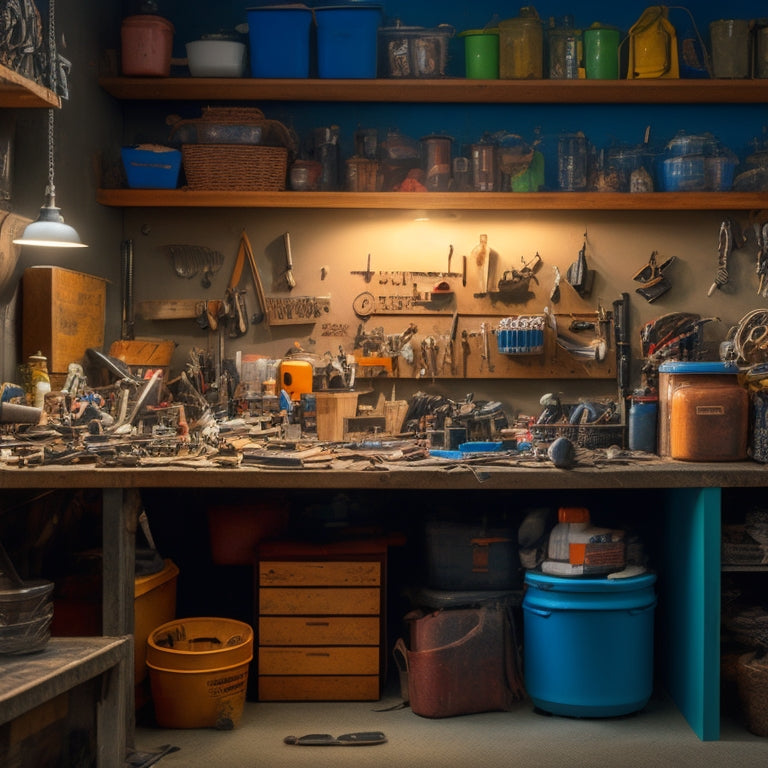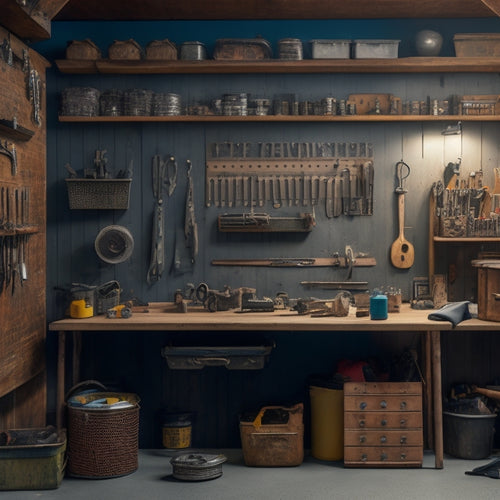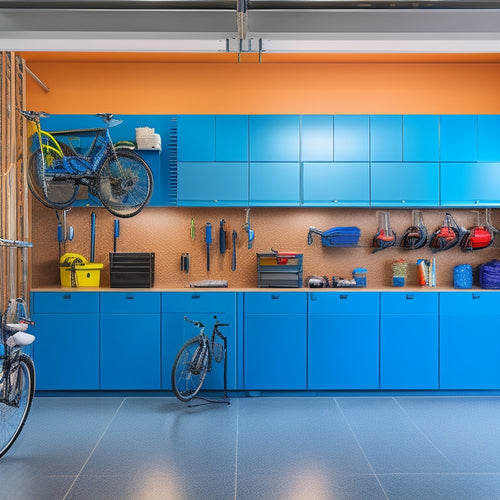
Why Cluttered Workshops Persist: 7 Storage Hacks
Share
You're stuck in a cluttered workshop, wasting precious time searching for tools and materials. But why do cluttered workshops persist? Often, it's due to a lack of designated storage areas, insufficient shelving, or a hoarding mentality. To break the cycle, you'll need to maximize your vertical space, optimize your toolbox organization, and utilize multifunctional tool holders. Implementing pegboard storage solutions and labeling tool zones can also help. By applying these hacks, you'll be well on your way to a more efficient and organized workspace. Now, take the next step towards transforming your workshop into a haven of productivity.
Key Takeaways
• Cluttered workshops persist due to a lack of designated storage areas, insufficient shelving, and failure to categorize items.
• Ignoring the importance of labeling and neglecting regular decluttering schedules contribute to workshop disorganization.
• Overcomplicating storage systems and using inadequate solutions hinder effective workshop organization.
• A hoarding mentality and neglecting to involve all workshop users in organizational efforts exacerbate cluttered workshops.
• Failing to establish regular cleaning schedules and implement a 'one in, one out' rule leads to persistent clutter in workshops.
Utilize Vertical Space Efficiently
Maximize your workshop's storage capacity by installing shelves, hooks, and pegboards that take advantage of often-wasted vertical space, allowing you to store more gear and supplies within easy reach. This is especially important for frequently used items, like tools and materials, that you need quick access to.
Consider wall-mounted shelving with hanging baskets to store small items like nuts and bolts, or screws and fasteners. This will keep them organized and prevent them from getting lost or scattered around the workshop.
Don't forget to look up – literally! Ceiling-mounted racks can be used to store infrequently used items like seasonal decorations or out-of-season equipment. This will free up valuable floor space and keep your workshop clutter-free.
Additionally, consider investing in ladder storage solutions, such as hooks or racks, to keep your ladders organized and easily accessible. By utilizing your workshop's vertical space, you'll be able to store more and work more efficiently, making your workshop a more productive and enjoyable space.
Optimize Toolbox Organization Systems
With your workshop's vertical space efficiently utilized, turn your attention to your toolbox, where a well-organized system can help you quickly find the right tool for the job and avoid wasting time searching for misplaced items.
To optimize your toolbox organization, consider these essential strategies:
-
Use drawer dividers to separate tools into categories, making it easy to locate what you need.
-
Install wall hooks to hang frequently used tools, keeping them within easy reach.
-
Label each compartment and hook to make sure you can quickly identify where each tool is stored.
- Designate a specific spot for each tool, so it's always returned to its home after use.
Choose Multifunctional Tool Holders
You can double the functionality of your toolbox by investing in multifunctional tool holders that can store multiple tools in a single spot. This is a game-changer for tool organization, as it allows you to maximize your available space while keeping your tools within easy reach. Look for holders with adjustable compartments and dividers to customize the storage to your specific toolset.
Multifunctional tool holders are especially useful for storing smaller items like screwdrivers, pliers, and wrenches. By keeping these tools organized and visible, you'll save time searching for them and reduce clutter in your workshop. Plus, with more free space, you'll be able to focus on your projects rather than wasting time on tool management.
When selecting a multifunctional tool holder, consider the type of tools you need to store and the available space in your workshop. Choose a holder that fits your toolset and can be mounted or placed in a convenient location. With the right multifunctional tool holder, you'll be able to streamline your tool organization and create a more efficient workspace.
Implement Pegboard Storage Solutions
Now that you've optimized your toolbox with multifunctional tool holders, it's time to take your storage game to the next level by implementing pegboard storage solutions that can help you organize and hang bulkier items like power tools and accessories.
Pegboard organization is a great way to maximize your workshop's vertical space and keep frequently used items within easy reach. Here are some benefits of implementing pegboard storage solutions:
-
Easy access: Hang your most-used tools and accessories on the pegboard, so they're always easy to find and grab.
-
Space-saving: Make the most of your workshop's walls by storing bulky items like power tools, extension cords, and hoses.
-
Customizable: Design your pegboard to fit your specific needs, with hooks, bins, and holders tailored to your tools and accessories.
- Visually appealing: A well-organized pegboard can add a touch of professionalism to your workshop, making it a more enjoyable space to work in.
Label and Categorize Tool Zones
Organize your workshop into distinct tool zones by sorting and labeling your pegboard sections. This tool organization strategy helps you quickly pinpoint where each item is stored, saving you time and reducing frustration.
By grouping your tools into categories, such as drilling, cutting, or measuring, you'll be able to find what you need in a snap. Labeling each section clearly guarantees that you and others can easily identify where items belong, promoting a sense of order and structure in your workshop.
Effective storage solutions are key to maintaining a clutter-free workshop. By labeling and sorting your tool zones, you'll be able to maximize your storage space and keep your tools organized. This, in turn, helps prevent lost or misplaced items, reducing waste and saving you money in the long run.
With a well-organized workshop, you'll be more productive, efficient, and able to focus on the tasks at hand. Take the first step towards a clutter-free workshop by implementing this simple yet efficient tool organization strategy today.
Designate Zones for Specific Tools
By assigning specific tools to designated zones, you'll create a logical and efficient workflow that streamlines your project execution. This approach to tool organization is essential for workspace efficiency, as it eliminates the need to search for tools and reduces downtime.
Here are some benefits of designating zones for specific tools:
-
Improved tool accessibility: Tools are easily accessible, reducing the time spent searching for them.
-
Enhanced clutter reduction: Assigning a specific zone for each tool prevents clutter from building up in other areas.
-
Increased productivity: With tools organized by zone, you can focus on the task at hand, rather than wasting time searching for them.
- Better maintenance: Tools are more likely to be properly maintained and serviced when they've a designated zone.
Create Mobile Storage Containers
When you create mobile storage containers, you'll want to label and categorize the tools you store inside, so you can quickly find what you need.
Consider adding roll-out supply drawers to make it easy to access frequently used items.
Label and Categorize Tools
Get a handle on your tool collection by assigning a designated spot for each item and grouping similar tools together in mobile storage containers. This will help you maintain tool identification and organization, making it easier to find what you need when you need it.
To take your tool organization to the next level, consider these strategies:
-
Categorize tools by function: Store tools that serve the same purpose, such as drilling or cutting, together in the same container.
-
Use a tool rack: Install a tool rack on a wall or on a mobile cart to keep frequently used tools within easy reach.
-
Implement shelving solutions: Designate specific shelves for specific types of tools, such as power tools or hand tools.
- Label everything: Use clear labels to identify what's stored in each container or on each shelf, so you can quickly find what you're looking for.
Roll-Out Supply Drawers
Create mobile storage containers by converting existing drawers or building new ones with wheels, allowing you to easily access and transport supplies throughout your workshop. This will enable you to bring the supplies you need to the project, rather than having to constantly walk back and forth to retrieve them.
Add drawer dividers and sliding trays to keep items organized and prevent clutter from building up inside the drawers. Consider installing under-bench storage with concealed compartments to maximize your workshop's floor space. This will allow you to store infrequently used items out of the way, while keeping your most-used supplies easily accessible.
Frequently Asked Questions
How Do I Maintain My Organized Workshop Over Time?
To maintain your organized workshop over time, you'll need to prioritize consistent upkeep, set aside time for regular cleaning, and implement sustainable habits, like labeling and categorizing, to sustain long-term organization and workshop maintenance.
Can I DIY My Own Pegboard or Should I Buy One?
You've seen YouTube star, The King of Random, create a DIY pegboard for under $20. Now, you're wondering if you should follow suit or buy a pre-made one. Weigh the cost: DIY might be cheaper, but a store-bought pegboard could save you time and hassle.
What Are Some Alternatives to Pegboards for Storage?
You're looking for alternatives to pegboards for storage. Consider wall-mounted shelves for easy access and visibility, or tool cabinets for secure, organized storage - both options keep your workspace clutter-free and efficient.
How Often Should I Clean and Declutter My Workshop?
"Like a garden, your workshop requires regular tending to flourish. You should clean and declutter your workshop at least weekly, prioritizing time management and workshop organization to prevent clutter and maintain workspace efficiency."
Are There Any Safety Considerations for Workshop Storage?
When organizing your workshop, you're not just decluttering, you're ensuring safety. You're avoiding fire hazards by storing flammable materials properly, and taking safety precautions to prevent tripping and falling hazards, keeping you and others safe.
Related Posts
-

Design Considerations for a Custom Pegboard
When designing a custom pegboard, you'll want to start by evaluating your storage needs, considering factors like too...
-

What Size Rolling Storage Bin Do I Need
To determine the ideal size of your rolling storage bin, you'll need to measure your storage space accurately, consid...
-

Top Garage Storage Bins for Organization and Style
You can enhance your garage's style and organization with the right storage bins. Top brands like Rubbermaid, Suncast...


